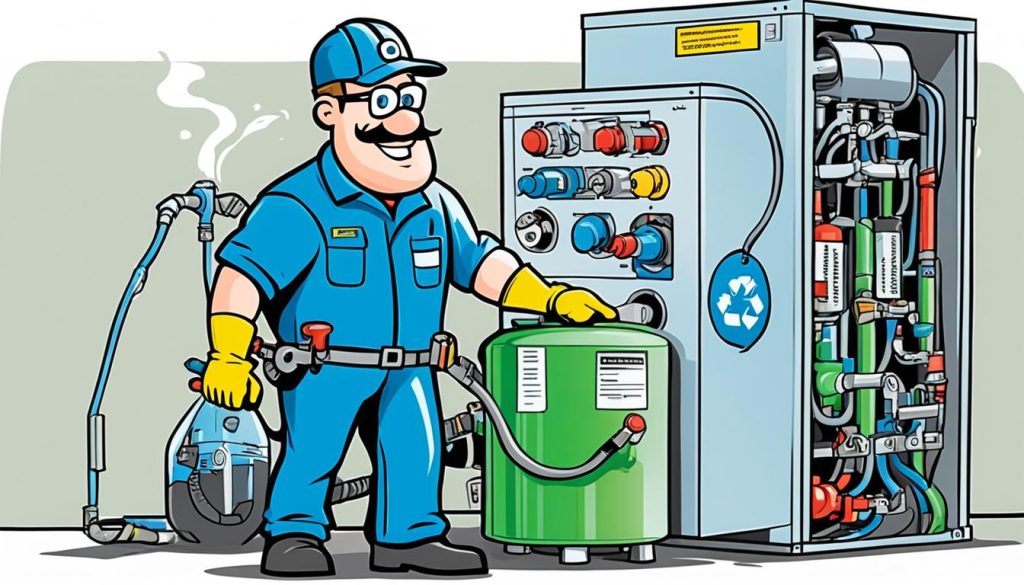You can make a big difference by managing refrigerants in your HVAC design. Using eco-friendly refrigerants and improving HVAC energy efficiency helps. This makes cooling systems better for your building and the Earth.
HVAC systems use a lot of energy, making up to 20% of electrical use. With air conditioning use set to triple by 2050, it’s key to manage refrigerants well and boost system efficiency.
Using new refrigerants and better HVAC designs can limit global warming from HFCs to just 0.06 degrees Celsius. This means using less energy, swapping out high-warming refrigerants for better ones, making refrigeration more efficient, and controlling leaks over the system’s life.
The HVAC industry is working hard to reduce HFCs and get more efficient to help fight climate change. Your part in this change is important. It includes designing systems well, recycling and destroying refrigerants at the end of their life.
Understanding the Environmental Impact of HVAC Refrigerants
HVAC systems keep us comfortable every day, but they also affect the environment. It’s key to know how these systems add to global carbon emissions. We must understand the need for Refrigerant Compliance Regulations.
The role of HVAC in global carbon emissions
HVAC systems use a lot of energy in buildings. Stationary air conditioning can use up to 20% of a building’s power. This means a lot of carbon emissions, making HVAC a big focus for the environment.
Common refrigerants and their global warming potential
Refrigerants like hydrofluorocarbons (HFCs) are very bad for the environment. They can trap heat up to 1,000 to 9,000 times more than carbon dioxide. This shows why we need to use refrigerants that are better for the planet.
The Montreal Protocol and Kigali Amendment
The Montreal Protocol started in 1989 to protect the ozone layer by getting rid of harmful substances. The Kigali Amendment in 2016 focused on reducing HFCs. This affects refrigerants like R-134a and R-410A, pushing for greener options.
Knowing these things is important as HVAC design and refrigerant management change. The move to Low Global Warming Potential Refrigerants and stricter rules is changing the industry. It’s driving new ideas in Green Refrigeration Systems.
The Importance of Transitioning to Next-Generation Refrigerants
Switching to next-generation refrigerants is key to lowering the environmental impact of HVAC systems. As we face climate change, the HVAC industry must use eco-friendly refrigerants for sustainable cooling.
R-32 is a top choice among low global warming potential refrigerants. It has big benefits over old refrigerants, making it great for those who care about the environment.
Studies show that electricity use can make up to 85% of carbon dioxide emissions from HVAC systems over their life. This shows why picking refrigerants with less environmental harm is crucial. They should also make systems more efficient.
Next-generation refrigerants like R-32 can make systems up to 12% more efficient than R-410A. This means big cuts in environmental impact over the system’s life.
| Refrigerant | Global Warming Potential | Efficiency Improvement | Charge Reduction |
|---|---|---|---|
| R-410A | 2088 | Baseline | Baseline |
| R-32 | 675 | Up to 12% | Up to 30% |
Using eco-friendly refrigerants like R-32 can greatly cut your HVAC system’s carbon footprint. These solutions meet new rules and help make our planet greener.
Exploring R-32 as a Sustainable Refrigerant Option
R-32 is a new name in eco-friendly refrigerants. It’s a promising choice for green cooling systems. It meets both environmental and energy efficiency needs.
Efficiency Benefits of R-32
R-32 shines in HVAC systems for its efficiency. It can increase efficiency by up to 12% over R-410A. This means more energy savings and less carbon emissions for cooling.
Reduced Usage and Charge Requirements
R-32 uses less refrigerant than R-410A in many cases. This can be up to 40% less. Less refrigerant means less environmental impact and supports green cooling goals.
Cost-effectiveness and Global Availability
R-32 is a budget-friendly choice for improving HVAC energy efficiency. It costs less per pound and needs less refrigerant. Plus, it stays quality over time. You can easily recharge and reuse it, adding to its value.
| Feature | R-32 | R-410A |
|---|---|---|
| Efficiency Improvement | Up to 12% | Baseline |
| Charge Requirement | Up to 40% less | Standard |
| Component Type | Single | Blend |
| On-site Reusability | High | Limited |
R-32 is becoming a top choice for eco-friendly refrigerants. Its wide availability and strong performance make it key for sustainable HVAC systems.
Reduce Environmental Impact with Refrigerant Management
Managing refrigerants is key to lowering the environmental impact of HVAC systems. By using smart strategies, you can cut down on greenhouse gas emissions. This helps make the future more sustainable.

Green refrigeration systems lead the way in protecting the environment. They use new technologies to reduce harmful refrigerants. By choosing these systems, you lower your carbon footprint and follow new rules.
Spotting refrigerant leaks is vital for good management. Regular checks and top-notch detection tools help find and fix leaks fast. This stops environmental harm and boosts system efficiency and cuts costs.
Recovering and recycling refrigerants is crucial in the HVAC world. When fixing or taking down equipment, using the right recovery methods keeps refrigerants out of the air. Recycling these refrigerants lowers the need for new production and cuts waste.
| Refrigerant Management Strategy | Environmental Impact | Cost Savings |
|---|---|---|
| Leak Detection and Repair | Reduced emissions | Lower refrigerant replacement costs |
| Recovery and Recycling | Decreased demand for new refrigerants | Reduced disposal expenses |
| Green Refrigeration Systems | Lower global warming potential | Improved energy efficiency |
Using these strategies can greatly help the environment. Project Drawdown says cutting refrigerant leaks to 0.4% in 30 years could save 89.7 gigatons of CO2. This shows how important good refrigerant management is for fighting climate change and a greener future.
Designing HVAC Systems for Lower Environmental Impact
Creating sustainable cooling solutions starts with smart HVAC system design. By focusing on HVAC energy efficiency, you can greatly reduce your environmental footprint. Let’s explore key strategies to achieve this goal.
Optimizing System Efficiency
To boost HVAC energy efficiency, consider using variable speed compressors and fans. These components adjust their output based on demand, reducing energy waste. Proper sizing of equipment is crucial too. Oversized systems consume unnecessary power, while undersized ones struggle to maintain comfort.
Minimizing Refrigerant Charge
Reducing the amount of refrigerant in your system is a simple yet effective way to lower environmental impact. Choose refrigerants with high latent heat capacity, like R-32. This allows for smaller components and less circulating refrigerant while maintaining performance.
| Refrigerant | Global Warming Potential | Efficiency | Charge Reduction |
|---|---|---|---|
| R-410A | 2088 | Baseline | 0% |
| R-32 | 675 | +10% | Up to 30% |
Implementing Leak Detection and Prevention Measures
Refrigerant leak detection is vital for maintaining system efficiency and reducing environmental impact. Install sensors at potential leak points and implement regular maintenance checks. Use advanced sealing technologies and high-quality components to prevent leaks from occurring in the first place.
By integrating these design principles, you create HVAC systems that not only perform better but also contribute to a healthier planet. Remember, sustainable cooling solutions are an investment in our future.
Best Practices for Refrigerant Handling and Recovery

Handling refrigerants right is key to less environmental harm in HVAC systems. By doing things the best way, you help with Green Refrigeration Systems and follow Refrigerant Compliance Regulations.
It’s important to train HVAC workers well. They need to know how to handle refrigerants safely to cut down on leaks and emissions. They should use special tools and gear for safe recovery and recycling.
Putting in good leak detection systems is also a must. Checking and keeping up with your system can stop small leaks from getting bigger. Catching leaks early cuts down on the harm to the environment and saves money on new refrigerant.
Recycling refrigerants at the end of an HVAC system’s life is a must. Right now, only about 3.4% of refrigerants are recovered and destroyed. Getting better at this can really lessen the environmental impact of HVAC systems.
- Use proper recovery equipment
- Store recovered refrigerants in approved containers
- Label all containers accurately
- Transport refrigerants safely to recycling facilities
Following these steps helps you follow the rules and supports a greener HVAC industry. Remember, managing refrigerants well is key to making and keeping Green Refrigeration Systems.
Regulatory Compliance and Industry Standards
Navigating Refrigerant Compliance Regulations can be complex. The HVAC industry has strict rules to protect the environment. Green Refrigeration Systems are key as we aim for Sustainable Cooling Solutions.
Current Regulations
The Montreal Protocol and its Kigali Amendment set the rules. They focus on reducing ozone-depleting substances and HFCs. Knowing these rules is crucial for compliance. Many countries have made these guidelines law.
Future Changes
Expect stricter rules on high-GWP refrigerants. Governments want more eco-friendly options. Get ready for these changes by upgrading your systems or changing refrigerants.
Industry Best Practices
Follow these best practices to stay ahead:
- Implement strong venting regulations
- Set up recycling programs
- Use proper refrigerant management techniques
- Adopt economic incentives for recovery and recycling
By following these guidelines, you’ll keep up with Refrigerant Compliance Regulations. This leads you towards Green Refrigeration Systems and Sustainable Cooling Solutions. Stay informed and adjust your practices to meet new standards.
The Role of Technology in Refrigerant Management
Technology is changing how we handle refrigerants in the HVAC world. Now, advanced leak detection systems can spot tiny leaks, stopping harmful emissions. These systems use sensors and software to warn technicians before big refrigerant losses happen.
Smart controls and variable speed compressors have made HVAC systems more efficient. They adjust their power based on what’s needed in real time. This cuts down on energy use and makes equipment last longer. These technologies make HVAC systems work better and are better for the planet.
Green refrigeration systems are getting more common. They use refrigerants that are better for the environment and have better designs. These systems have improved heat exchangers and insulation for better cooling and less refrigerant use. Some systems even use natural refrigerants like CO2 or ammonia, which is even better for the planet.
Refrigerant recovery and recycling have gotten a lot better too. New machines can take out and clean used refrigerants more effectively. This reduces waste and the need for new refrigerants. It’s key for managing refrigerants in a way that’s good for the planet and follows strict environmental rules.





0 Comments